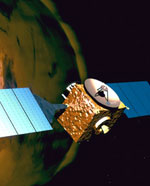
Image credit: ESA
Unlike its missing passenger, Beagle 2, controllers from the European Space Agency know exactly where Mars Express is – exactly where they want it. The spacecraft is currently on a wide equatorial orbit which brings it as close as 400 km and then out to 188,000 km away from the planet. Engineers are preparing the spacecraft for a further burn of its main engine which will bring the spacecraft into a closer polar orbit around Mars. Once Mars Express modifies its orbit, it will be the best candidate to communicate with the missing Beagle 2; starting January 4, 2004.
The Mars Express orbiter, mothership of Europe’s first mission to the Red Planet, is in a stable and precise orbit around Mars.
The essential Mars Orbit Insertion (MOI) manoeuvre had been completed on 25 December at 3:47 CET. This brought the spacecraft as close as 400 kilometres to the surface of Mars.
Afterwards, the spacecraft went into a highly elliptical orbit, going as far as 188 000 kilometres away from the planet. The most essential part of the Mars Express mission is performing very well and we are expecting exciting science from January 2004 onwards.
Today, 27 December, the mission control team at ESOC prepared the next steps to turn Mars Express from a near-equatorial orbit into a polar orbit. Michael McKay, Mars Express Flight Director explained, “Our flight dynamics and flight operations teams thoroughly discuss, evaluate and prepare the commands to perform a series of manoeuvres starting with a major move on 30 December – where we will fire the main engine again for three minutes.
“These key manoeuvres will allow us to get even closer to Mars. They will not only allow us more frequent ‘overflights’ of the Beagle 2 landing area, but also ensure the beginning of the orbiter’s science mission. As Mars Express is the planned main communication partner of the Beagle 2, the chances of obtaining a signal strongly increase with these manoeuvres after 4 January 2004.”
Close European and international co-operation
The ESA control team at ESOC are in regular contact with their colleagues of the Beagle 2 team and the Jodrell Bank telescope in the UK, with NASA ground stations and with several other European partners (UK, Germany, Netherlands, etc.). Many international offers have been forthcoming to support the search for the Beagle 2 lander.
Original Source: ESA News Release

Thank you for your help!
Thanks for helping us out!